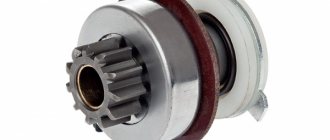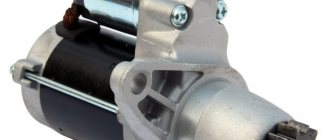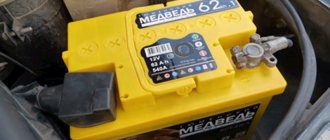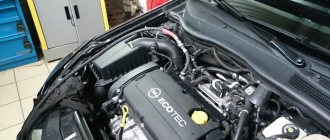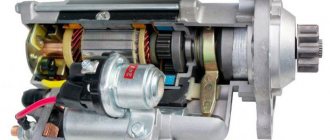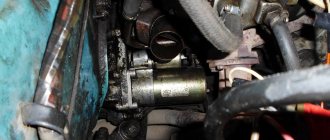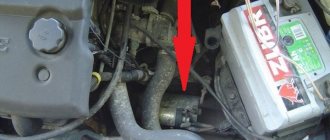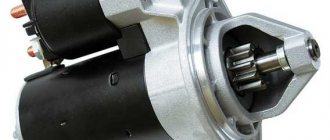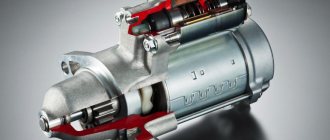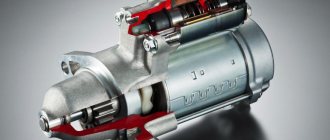VAZ starters, despite their reliability, durability and endurance, still fail sooner or later.
The average starter life is usually 5-6 years, which is half the life of the engine. And whether there is a malfunction of the VAZ 21093 starter, or the VAZ 2109 or 21099 starter does not turn, the problem will still have to be solved by diagnosing, repairing, and possibly even replacing this electrical component.
Since the VAZ starter design differs only slightly, we will take into consideration the situation when the VAZ 2109, 21099 starter does not turn.
After turning the key in the ignition, you may find that:
- VAZ 2109,21099 starter does not work after a single click;
- The VAZ 2109, 21099 starter does not work after a whole “trill” of frequent successive clicks;
- The starter response to turning the key is completely absent.
What to do if the starter does not work? Of course, look for the cause of this phenomenon and try to eliminate it.
VAZ 2109, 21099 starter does not work after one click
reasons why the VAZ 2109, 21099 starter does not turn after a single click.
The power bolts on the solenoid relay may have burnt out. This defect leads to the fact that from the supplied 12V, only about 6-7V reaches the starter.
The fork that pushes out the starter bendix may be bent, broken, or otherwise deformed. In this situation, the bendix does not fully fit the flywheel; the cores only partially enter the coil, preventing the contacts from closing.
The teeth on the Bendix sprocket have worn out. Because of this, the solenoid relay cannot transmit voltage to the starter.
Also, the cause of the phenomenon of “one click” of the starter may be either worn-out brushes or armature bushings, or a short circuit in the winding.
VAZ 2109, 21099 starter does not work after frequent clicks
A crackling sound from the starter in response to turning the key in the lock may indicate the need to charge the battery and check whether the terminals on it are oxidized or loose.
Repeated clicks are repeated due to the fact that the retracting winding retracts the core, and the holding winding cannot hold it and lets go. This can continue until the battery runs out completely.
VAZ 2109.21099 starter does not work and there is no response to turning the key
The absence of any response from the starter to turning the key in the lock sometimes indicates a short circuit in the windings (if smoke and a burning smell appears from the starter when you try to start).
If the lack of starter response is not accompanied by “special effects” in the form of smoke and a characteristic odor, you should pay attention to the condition of the additional relay and the contacts of the battery terminals.
The same reaction of the starter is observed when the ring in the starter gearbox is partially destroyed.
If the starter does not respond to turning the key in the lock, you need to take into account that the reason may lie in the key itself. If the check confirms this, it will be enough to just replace the ignition key to fix the problem.
It may also happen that after removing and disassembling the starter, you will not find any damage. Do not rush to replace it with a new one or go to a car service center. Perhaps after you clean the starter, apply new grease and reinstall it, it will come back to life.
After you find and fix the starter malfunction, try not to cause it to break down again in the future, because this lightweight device already has a hard time - the rotation of the massive flywheel and the start of movement of the entire piston group of the engine depend on its serviceability.
Popular causes of malfunction
The most common reasons account for about 95% of all cases when the starter does not turn. That’s why we pay attention to them first.
We recommend: Correct installation of piston rings
The starter does not turn differently in different situations. It is important to take this into account and clearly monitor all associated symptoms. So, even without the help of specialists, you will be able to return the unit to operation and resume normal operation of the ignition system
| Situation | Probable Causes |
| There is one click, after which the starter goes silent. |
|
| Multiple clicks occur in succession |
|
| Clicks are completely absent, as are other signs of starter life. |
|
Bendix
Often, simply disassembling and cleaning the internal components of the starter can eliminate problems with its functionality. Therefore, after removing the device and not finding damaged elements inside it, try to thoroughly clean everything, assemble it and put it back in place. It is likely that the starter will start turning.
General reasons why the VAZ 2109 starter does not turn
- There is only one click, and then silence.
- You hear several clicks in succession.
- There are no clicks or other signs of life.
- The power bolts on the retractor relay - they were burnt. Because of this, a voltage of less than the required 12 volts reaches it.
- The fork pushing out the Bendix – it could have broken or been somehow deformed. Because of this, the Bendix does not fully reach the flywheel, the cores only partially enter the coil, and the contacts open.
- In the Bendix - the teeth on it were worn out. Therefore, there is no voltage from the solenoid relay at the starter.
- Armature brushes or bushings - they are worn out.
- Winding short circuit.
- The battery is dead.
- Its terminals - they have become sour or weakened.
- Holding winding - it poorly fixes the core, which is retracted by the retracting winding.
- Short circuit of the winding - in this case you should smell a burning smell and see smoke.
- The ring located in the starter reducer - it has collapsed.
- The key is to try to replace it.
How to fix starter malfunctions with your own hands
The electrical component of the starter consists of the following structural elements:
- winding;
- brush assembly;
- solenoid relay.
When checking the solenoid relay, skip the starter operation, bypassing its switching. The relay has 3 terminals at once, one of which is the control terminal. The remaining 2 large terminals, located at the input to the battery and at the output of the starter, are closed using a screwdriver or wrench. Closing for a short period of time is enough, the main thing is that the tool you are using does not touch the metal body directly under the hood.
Observe the changes in the starter during the process of closing the terminals - if the device rotates, perhaps with a clearly audible crackling sound, then the fault is caused by the solenoid relay.
Remember that starting the engine in this way is prohibited, because the main gear of the device does not engage.
Most likely, the contact planes on the inner plane simply burned out, and therefore a dielectric layer of metal oxides formed on top. To burn the contacts, there is no need to make great efforts; just one start of the VAZ-2109 engine is enough.
There are 2 ways to repair the VAZ-2109 solenoid relay:
- Dismantle the device and disassemble it into components, clean the contacts.
- If it is financially possible, it is better to replace the relay completely. Practice shows that if a relay fails, the contacts will have to be cleaned more and more often to restore its operation. If you want the repaired relay to last a long time, give preference to this option for repairing the starter if the device does not spin or click.
Dismantling
There should be no problems with the dismantling process. The main thing here is to remove the starter, since the required relay is held on it. Therefore, dismantling is carried out as an assembly.
- Turn on the handbrake, disconnect the battery by removing the negative terminal from it.
- A wire with a large cross-section goes from the battery to the contact of the relay. It can be turned off by unscrewing it using a 13 key.
- Remove the thin winding power wire from the solenoid relay.
- Using the same 13mm wrench, unscrew the three mounting nuts holding the starter to the clutch block.
- You can remove the device through the bottom or top. If you chose the top, then you need to slightly rotate the starter around its axis and remove it.
- The lower output is more difficult, since here you need to remove the crankcase protection. But if parallel work is carried out that requires similar manipulations, problems will not arise.
Individual situations
If the VAZ 21099 injector stops starting, you can try to close the contacts of the mechanism in a straight line.
But sometimes there are emergency situations when the device stops functioning, let’s consider a few of them:
- The injection engine does not start in cold weather, but all devices work normally, the battery is charged. If there is no click, you should first diagnose the safety components, electrical circuit, and also the solenoid relay. If the device clicks, the relay must be replaced.
- The starter turns all day, there is a spark, but in the evening the engine stops starting. Before checking the starter, it is necessary to fully charge the battery, and then clean the contacts on both the battery and the mechanism itself. If these steps did not help solve the problem, you need to check the battery itself more carefully - try closing the contacts with a wire, which may cause a spark to melt. If this does not help, try applying a positive charge from the battery directly to the relay. If there are no changes, the unit will have to be replaced.
- If the car was operated normally all day, but after parking for five minutes it stopped starting, you can try to close the mechanism. You need to directly close two bolts on the relay; if this helps, but later the problem reappears, then disassemble the unit completely. Most likely, the problem lies directly in the erasing of the brushes. In this case, they will need to be changed.
- The unit does not turn at all, but the car can be started from the pushrod. If the problem is not with the starter, then check the fuse box and ignition switch. But before this, you should check the wiring - the reason may lie in the oxidation of the contacts.
We recommend: How to replace the steering column switch?
Solution
- First you need to put your “nine” in neutral gear, and also turn on the parking brake.
- After this, the hood opens, you need to find the red cable on the retractor.
- Using a thick screwdriver, you need to short-circuit the terminals on this component. When a short circuit occurs, sparks may fly in different directions - there is no need to worry, this is a normal situation.
- Then you need to try to start the engine. If you notice that the starter starts to work normally when screwing in, then the problem is not with it. If the device does not turn, then most likely it will need to be changed.
- If the mechanism is working properly, the red wire from the solenoid relay must be removed, and voltage from the battery must be applied to this terminal. If there is a pop, the relay will be fully operational. If there was no clap, then most likely the reason lies precisely in the relay.
- Check the contacts on the starter, it happens that due to oxidation it stops turning.
Device
- retaining ring
- restrictor ring
- overrunning clutch drive
- lever axis
- front cover
- drive lever
- armature relay
- traction relay
- back cover
- protective cover
- lock washer
- pinch bolt
- shim
- brush spring
- brush
- frame
- anchor
Other reasons why the starter may not respond when the ignition is turned on
In some cases, there have been malfunctions in the operation of automobile anti-theft systems (car alarms, immobilizers). Such systems simply block the supply of electric current to the starter after the security mode is removed. At the same time, the diagnostics shows the full functionality of the battery, power contacts and other elements of electrical equipment that are involved when starting the engine from the starter. For an accurate determination, it is necessary to directly supply power from the battery to the starter, that is, bypassing other systems. If the starter works, then there is a high probability of failure of the car's anti-theft system or immobilizer.
The next item to check is the solenoid relay. If it breaks, the starter can:
Bendix and retractor
The above symptoms will indicate that the fault is localized to the solenoid relay or the bendix does not engage the flywheel. Note that in the case of Bendix, a more characteristic sign is that the starter crunches and does not turn the engine. Another common sign of a bad starter is that the starter buzzes but does not turn the engine.
To check the traction relay, voltage must be supplied from the battery to the power terminal of the relay. If the engine starts to turn over, then the retractor starter is obviously faulty. A frequent breakdown is the burning of the contacts. To eliminate it, you will need to remove the relay to clean the nickels. After cleaning, you must still be prepared to quickly replace the traction relay, since in the factory the contact pads are covered with special protection that resists burning during operation. Stripping will mean that the specified layer is removed, as a result of which it is difficult to predict the moment when the retractor coins will burn again.
Now let's turn our attention to the starter bendix. Bendix is a gear through which torque from the starter motor is transmitted to the flywheel
The Bendix is mounted on a single shaft with the starter rotor. To better understand, it is necessary to understand how a starter works. The principle of operation is that after turning the ignition key to the “start” position, current is supplied to the solenoid relay. The retractor transmits voltage to the starter winding, resulting in the engagement of the bendix (gear) with the flywheel ring gear (flywheel ring gear). In other words, two gears are combined to transmit the starter torque to the flywheel.
Wear of the Bendix gear means that there is no normal connection with the flywheel ring. For this reason, a cracking sound may be heard when starting the engine, and the starter may spin freely without engaging and buzzing. A similar situation arises if the teeth of the flywheel rim are heavily worn. The repair involves disassembling the starter to replace the bendix and/or removing the transmission to replace the flywheel. To check the bendix yourself, you will need to close two power contacts on the traction relay. The electric current will bypass the relay, which will determine the rotation of the starter. If the starter rotates easily and hums, you should check the quality of engagement of the bendix with the flywheel.
Rare situations
They happen noticeably less frequently than those we described above. But under no circumstances should we exclude them.
After reviewing the situations below, compare them with the behavior of your starter and a car that has stopped turning or clicks but does not turn.
- With an injection engine at a frosty temperature of about -20 degrees Celsius, all devices function. This indicates that the battery is fully charged. At the same time, for some reason the starter refuses to turn. Your actions:
- If there are no clicks when you try to start the engine, check the condition of the fuse, wiring and solenoid relay;
- If there is a clicking noise, the most likely source of the problem is the solenoid relay. It must be replaced.
- The engine started normally throughout the day, but in the evening it suddenly stopped working normally. When you turn the key in the ignition switch, there is only a click, but the starter does not turn. When you try to start the engine several times in a row, several clicks are heard. Your actions: Charge the battery;
- Crimp, strip and tighten the contacts on the starter and battery;
- If the first two points do not produce results, check the battery itself. To do this, the wire closes its contacts. If the battery is working properly, a spark will appear that melts the wire;
- Connect the plus from the battery directly to the solenoid relay. If the starter is silent, replace the starter.
car battery
- During the day the car started without problems. But after being idle for several minutes, attempts to start the car fail. When you turn the key, the relay is activated, but the starter stubbornly refuses to turn. By closing the two bolts of the solenoid relay, everything started. We reached our destination, stopped, and turned off the engine. When I try to start again, the same situation occurs. Just locking the bolts no longer works. Your actions:
- Disassemble the starter housing;
- Check the condition of the brushes. There is a high probability that they have been completely erased. Hence this effect;
- Replace the brushes with new ones. This is cheaper than completely replacing the unit.
- The starter doesn't turn over. When you try to close it, only noise arises, like when a drill is working. The engine shows no signs of life. But it was possible to start it from the pushrod without any problems. Your actions:
- Make sure your starter is working properly;
- If everything is fine with it, go to the mounting block and check the fuses;
- Also examine the condition of the ignition switch. It is possible that the problem is with him;
- Do not forget to check the wiring for breaks and short circuits;
- Check the status of the contacts. It’s not uncommon that minus does not reach the starter relay only for the banal reason of oxidation or burnt wire.
We recommend: Everything about replacing the cylinder head gasket on a VAZ 2112 car
Having understood the reasons for the failure of the starter, you can bring the device back to life on your own. Don't rush to throw away your old starter and buy a new one. The practice of VAZ 2109 owners shows that partial repairs, and sometimes even simple cleaning of the device, make it possible to restore the functionality of one of the main elements of the ignition system for a long time.
Design and operating principle
To understand the features of the repair, you must first study the design of the starter and understand how it works for the benefit of your car.
Let's start with the design. It includes four main nodes.
| Knot | Peculiarities |
| Electric motor | It transmits direct current through four brushes |
| Freewheel with gear | A clutch or bendix drives the flywheel of your car's engine. |
| Traction relay | Serves to extend the bendix with gear when turning on the electrical appliance |
| Bushings | Ensure easy rotation of the clutch, rotor, and gear. One bushing is located inside the starter, and the second is in the clutch housing. |
Device diagram Having familiarized yourself with the starter diagram, you can discuss the principle of its operation.
The operating principle is to convert an electrical signal into the rotational movement of a drive gear. Current is transmitted through the brushes to the poles of the electric motor. At the same time, the clutch extends and the gear is connected to the flywheel ring. To start the engine you need a quick but easy rotation of the starter. When the engine starts, the clutch returns to its original position.
How to charge the battery in a VAZ-2109
If the starter malfunction is due to lack of battery charge, start charging the device. To properly charge the battery, carry out the procedure in a ventilated room. It is not necessary to remove the unit from the car; the process can take place directly in the VAZ-2109. When charging the battery, follow these requirements:
- Disconnect all electrical cables.
- Immediately before charging, carefully clean the terminals from adhering dirt and dust, paying special attention to oxidized areas.
- It is advisable to completely discharge the battery before charging - to do this, turn on all electrically powered devices.
- Observe the movements of the ammeter needle; it should approach the zero mark.
- Monitor the temperature of the electrolyte - it will increase during charging. For example, the temperature of the electrolyte has increased to 40 degrees, then the current should be halved. If within 2 hours the density of the electrolyte and the battery voltage in the VAZ-2109 remain unchanged, it means that the battery is fully charged.
Typically, 10-12 hours are enough to charge the battery. Please note that in the summer the electrolyte in the VAZ-2109 heats up at an accelerated pace, so the car owner’s task is to regularly check the density and level of the material.
Special cases
- Charge the battery.
- Clean and compress the contacts on the battery and starter.
- check the battery - close the contacts with a wire, a spark should appear that will melt it;
- pass the plus from the battery directly to the solenoid relay.
In the morning the starter turned, after 15 minutes I warmed up the car, then started it, but it didn’t move, the starter closed just a spark and silence, what should I do? I installed a new relay
If the devices go out when you start them, then look at the wiring near the battery, if not, then look at the retractor, try to tap it well, if it’s just stuck, then when it helps. And charge the battery well.
VAZ 2110 injector, started it on autostart, worked for 10 minutes and stalled. Now I can’t start, the starter doesn’t turn, can you tell me what’s the reason?
When you start it, the starter only makes a click, but if you connect it directly, it just turns.
Exal everything was normal and suddenly the car stalled, the panel went dark, then after 10 seconds everything turned on again, released the clutch, started. Everything is fine, I arrived, installed it, then started it, turned the key - the starter doesn’t turn, but turns straight.
The car was working normally, I came to put it in the garage, start it, but there was only a click and no movement, there was no current on the positive wire. What reasons could there be?
There may be no mass from the engine to the passenger compartment, the pigtail has broken
The starter stopped turning, everything else works. Start from the pusher, what could happen?
If it turns straight, there may be a problem with the mounting block or ignition switch. Check the voltage on the retractor, although it may be there, but the current strength is not enough to operate the relay.
The starter doesn't turn. You close the bolts - it turns, and starts with half a turn. He doesn’t want to use the key, the relay clicks once and there’s silence. What could be the matter?
Look, this thing is about the retractor :)
VAZ 2109 injector, this is the problem, started it half a turn, drove 30 km and the car stalled, all the devices went out, checked the wires on the generator, on the battery, but it didn’t help , a day later I started it at idle, it works, but when you give it gas it starts to burn! It worked for a little bit and stalled and all the devices went out again, no signs of life, tell me what could be the reason?
I started the car (2109i), drove for 1-2 km, and heard the sound of a tick-tick-tick. etc. almost at the same frequency, the revs were all right, after 500m I stopped, opened the hood (I didn’t turn off the car), there was a sound, then I turned off the car, tried to start it - no noise Lo, one click, the instrument panel lights up, no trills from the starter side, one click and silence, the towbar did not start (it was in 3rd gear, released the clutch - silence). The battery is normal, I cleaned the terminals, nothing, changed the battery - nothing. The idle speed sensor began to crackle every time I turned the key. I connected the starter directly to the battery - silence, changed the ignition relay - silence. The car has an immobilizer installed - it works now differently than before - When you turn the key so that the dashboard lights up, it should flash - it requires a key - now it just doesn’t flash, you take it out the key or in the “off” position the immobilizer diode lights up steadily. I blame him for now, maybe he blocked everything for me. There are no other explanations yet.
Why is it needed, its price, how much will the auto service charge for replacement, what malfunctions can arise, what the danger is, how to fix it, etc.
The door on the six closes with noise, and for this you need to make an effort? This article will tell you how you can get rid of the problem. This article talks about silent locks on the BAZ 2106. You will find out how much they cost and how to install them.
Where is it located (depending on the year of manufacture); when should it be changed and how to do it? And also get advice that will protect you from making a serious mistake.
Common causes of failure
Identification of starter components
If on a VAZ 2109 the injector or carburetor stops starting the engine, and the starter does not click, this may be due to various malfunctions.
In general, it should be noted that there can be several options for a malfunction of the starter unit:
- When you turn the key, the device operates once, that is, only one click is heard.
- When I try to start, there are several clicks, but the engine does not start.
- The starter on the VAZ 2109 carburetor does not work completely - there are no clicks.
If the injector does not start, and the starter unit makes only one click, the cause of the problem may be:
- power screws on the solenoid relay, these elements could burn out, as a result of which the voltage supplied to the mechanism will be less than 12 volts;
- a fork designed to push out the bendix, this component could wear out, break or become deformed, as a result the bendix cannot reach the flywheel normally;
- if the car does not start with the key, the teeth on the bendix may have worn off, as a result of which there will be no current from the relay to the starter device;
- wear of brushes or bushings of the so-called anchor;
- winding short circuit.
Starter unit "nine"
If the device clicks several times, but does not turn the engine and, accordingly, the VAZ 2109 does not start, then there may be several reasons:
- the battery is dead;
- oxidation of the terminals occurred, as a result of which they became loose;
- The holding winding of the system cannot properly fix the core.
You can turn the key as much as you like, but if the mechanism does not show any signs of life and the engine does not start, then the cause of the malfunction may be as follows:
- short circuit of the winding, if this is the case, then you will hear a burning smell in the car interior, and smoke may even appear;
- collapsed as a ring located in the gearbox;
- very rarely the problem is the key.
If you have dismantled the mechanism and found no damage, try cleaning it and reinstalling it. It is quite possible that after this the VAZ 2109 starter will start working normally (the author of the video is the Avtoelektika HF channel).
Dismantling
There should be no problems with the dismantling process. The main thing here is to remove the starter, since the required relay is held on it. Therefore, dismantling is carried out as an assembly.
- Turn on the handbrake, disconnect the battery by removing the negative terminal from it.
- A wire with a large cross-section goes from the battery to the contact of the relay. It can be turned off by unscrewing it using a 13 key.
- Remove the thin winding power wire from the solenoid relay.
- Using the same 13mm wrench, unscrew the three mounting nuts holding the starter to the clutch block.
- You can remove the device through the bottom or top. If you chose the top, then you need to slightly rotate the starter around its axis and remove it.
- The lower output is more difficult, since here you need to remove the crankcase protection. But if parallel work is carried out that requires similar manipulations, problems will not arise.
Circuit breakers
VAZ 2109 cars have a rather impractical location of the fuse box - between the windshield and the engine compartment. All dirt, dust and other deposits accumulate on this block.
If the lid is not sealed, moisture may get into the elements after rain, causing them to short out. The most basic one in our case is the fuel pump fuse. If it burns out, the fuel is unable to pass from the gas tank into the chamber. And no amount of “purging” will save you here. To avoid getting into such a ridiculous situation, experienced drivers are advised to always carry a set of new fuses with them.
Dirty filter
Its blockage leads to the fact that the VAZ 2109 does not start
And it doesn’t matter whether it’s a carburetor engine or an injection engine. It's easy to check the condition of the air filter
On both carburetor and injection engines, you should remove the housing cover (the only difference is that on the first it is iron, and on the second it is plastic). Next, we take the element out and look at its condition. Paper filter elements should be light-colored. If they contain particles of dust and dirt, air cannot pass through them into the combustion chamber. Hence it turns out that the VAZ 2109 carburetor does not start: the starter turns, there is a spark. In winter, periodically inspect its external condition. A filter like the one in the photo on the right can no longer be used.
Yes, this will not harm the engine, however, there will be frequent interruptions in operation. As a result, the chamber will be filled with a too lean mixture - hence the lack of “traction”, power, failures in acceleration and high fuel consumption. By replacing this part with a new one, you will get rid of all these problems at once. By the way, the manufacturer recommends changing the air filter at least once every 10 thousand kilometers. If the car is driven in rural areas, where there are mainly dirt roads, this period should be divided into two. Dust and dirt are the main enemies of the filter.
Step-by-step instruction
By following a certain sequence in your actions, you will eventually be able to determine on your own why the engine does not start or problems arise with it.
| Repair stage | Your actions |
| Turn the ignition key, check the starter | If the key turns and the starter turns, then this is definitely not the reason. Even if the engine doesn't start. A failure of the starter indicates the need to replace it. |
| Check the fuel level in the tank | You should not rely only on the sensor readings. He sometimes cheats. More than once it happened that a car owner went through almost the entire car, rebuilt the carburetor, and in the end it turned out that the fuel had simply run out. It may be funny, but it’s still worth checking for yourself that there is fuel in the gas tank. |
| Make sure there is spark | Remove any of the spark plugs, connect to the high voltage wire and touch ground (engine). You will need a partner to sit behind the wheel and turn the starter. If a spark appears at the tip, everything is fine. Is she not there? Blame the switching unit and replace the switch with a new one. |
| Check for spark on the center wire from the coil | A test method similar to the spark plug is used. If no spark is detected, most likely the coil has failed. Replace element |
| If it's freezing outside, there may be water in the gasoline, which eventually turns into ice. To check this, open the air valve and press the fuel pump button several times. The sound of gurgling sounds indicates that gasoline is flowing to the carburetor. The absence of rolls will not allow starting the carburetor when cold, since the fuel is partially frozen. You'll have to change the fuel pump here. | |
| Fine filter | Look at the condition of the filter. If cracks, damage and other visible defects appear on it, the element will have to be replaced |
| Gasoline supply hoses | Make sure that the hoses supplying gasoline from the pump to the engine are intact. In case of defects, damage, cracks, they must be replaced with new ones. |
| Spark plug | We've already checked the spark. Now unscrew all the spark plugs and inspect them for traces of carbon deposits. If the spark plugs turn out to be black from soot or filled with gasoline, there is no point in cleaning the units with ordinary sandpaper. You will not achieve the desired effect. The only recovery solution is to heat them on a gas stove. If you don't want to try this method, just install a new set of quality spark plugs |
| Distributor high voltage wires | Remove them and check for integrity and absence of damage. If there are any, buy a new set and install it on the car |
| Distributor cover | The presence of chips and scorched contacts inside it indicates wear and loss of functionality. There is only one way out - change devices. It is worth changing the slider at the same time as the lid. |
| Hall Sensor | Quite often the carburetor does not start precisely because of a faulty Hall sensor. It is held on the distributor with two bolts. Unscrew the fasteners, disconnect the wires and replace the old sensor with a new one. Put everything back together, check the carburetor's functionality |
| Location of distributor high voltages | It is not uncommon for inattentive craftsmen or inexperienced craftsmen who repair their car themselves to make mistakes when reassembling the distributor. High voltage wires must have a specific connection. The wire marked on the cover with the number 1 comes from the leftmost (first) cylinder, then clockwise goes cylinder 2, then 4, and only then 3. If you mix up the location, the car will start to shake wildly or you will not be able to start the carburetor at all |
| You can find the timing belt on the left under the casing. Remove it and evaluate the condition of the belt teeth. If they are partially loose or fall off, it is better to replace the belt with a new one. It is also possible that the valves on the 1.3-liter engine were bent. It is strongly not recommended to resolve this issue on your own. |
If a step-by-step check of each component of the VAZ 2109 car did not allow you to find the answer to why the carburetor cannot start properly, you will have to go to a service station.
Practice shows that a detailed inspection of the machine’s components and replacement of worn-out, damaged elements immediately returns the carburetor to its previous functionality; it starts without problems both cold and hot.
Often, drivers are faced with the fact that their VAZ 2109 stops starting
for some reason. If the car does not start, the question immediately arises, “Where to start?” In fact, everything can be quite simple, and in 90% of cases this is a typical problem that is quite easy to diagnose and solve.
Consequences of long-term rotation
Starting the engine is a manipulation in which the starting device and the battery are directly involved. It is these components of the car that suffer the most during a long start-up. And the sad consequences will not take long to arrive.
Here, for example, are some possible problems.
Prolonged operation of the starter leads to battery discharge. Valuable charge is consumed every time the engine is started, and if the attempt is unsuccessful, the battery wastes energy.
The fact is that the standard process of releasing current and receiving it in the battery occurs like this: first, the battery sends an impulse to the starter, which should start the engine in a short period of time, and then the battery receives voltage during engine operation and is charged again.
The starter deteriorates because when cranked for a long time it overheats, and this negatively affects its parts and leads to complete failure of the starter.
It is also important to remember about the bendix, which is supplied to the crank shaft during startup. If the engine does not start, then the splines on the bendix or on the bearing are ground off
And so every time. It is obvious that constant prolonged rotation of the starter will ultimately lead to failure of the listed elements.
- Absolutely legal (Article 12.2);
- Hides from photo and video recording;
- Suitable for all cars;
- Works through the cigarette lighter connector;
- Does not cause interference to radios and cell phones.
The starter clicks but does not turn, what is the reason?
Good afternoon. Many car enthusiasts are familiar with the situation when the starter clicks but does not turn. As luck would have it, such situations happen at the most inconvenient moments, for example, at gas stations or when leaving for work.
In today's article, we will tell you how to determine the malfunction and, if possible, start the car to get to the repair site.
Before telling the troubleshooting algorithm, let's look at the starter device. For clarity, watch this video:
As you can see, the starter is a regular DC motor and relay. When you turn the key in the ignition and hear a click, it is the solenoid relay that clicks (the coil and contacts at the top of the screen in the video). If the starter does not rotate, but clicks, the following options are possible:
- The battery is dead.
- starter relay failed
- The contact coins in the solenoid relay are burnt.
- The starter brushes are worn.
- the starter armature is jammed.
- power plus is not supplied to the starter (because if there is no mass there will not even be retractor clicks)
Below we will analyze each of these faults in detail, and tell you which faults will allow you to start the car on the spot, using the existing starter, in order to get to the service station.
A severely discharged battery is the most common cause of clicking noises when turning the ignition key.
The error looks like this:
In our video you can see that when starting, at first, the starter barely turns the engine, and then it just crackles…. If the battery is severely discharged, the starter will not even try to crank the engine but will immediately make nasty clicking noises.
The fact is that the battery voltage is not enough even to operate the solenoid relay!
Options to solve the problem:
- light a cigarette from another car (we have a separate article about this on our website).
- start the car from a pusher/tug (if it has a manual transmission).
- remove and charge the battery.
Other problems
Both on the carburetor and on the injector, the main reason that prevents the engine from starting is problems with the starter. If it does not rotate, then you will have to figure out why. Possible breakdowns:
- winding break;
- solenoid relay failure;
- poor contact in the wiring;
- discharged battery.
Also, the car may not start due to lack of gasoline.
The ignition coil and lock will have to be checked if nothing else helps. When it turns out that the problem is in the first one, it is removed and replaced with a new one. In the second case, first of all, look to see if the wire has broken somewhere.
In the ignition system, the distributor is also a vulnerable element. Remove the cover from it - if it is damaged, replace it. You need to do the same with the slider and hall sensor.
In winter, condensation sometimes freezes in the fuel rail. Warming up with a hairdryer or blowing with a compressor helps.
A few clicks
The VAZ 2109 starter does not work when you hear several clicks after you insert the key into the ignition and turn it. However, these few clicks immediately notify the driver of the cause of the breakdown:
- The holding winding began to weakly fix the core;
- Your battery is dead;
- The terminals are loose.
{banner_content}
To start
charge the battery
, because it very often leads to the car not starting. If this does not help, then check the winding and terminals. Both parts can be replaced very easily if you have the slightest understanding of your car's design and mechanics. However, every driver must know such basic things, otherwise you will often get stuck in the middle of the road.
Candles
Unscrew the spark plug, place it against ground and crank the starter.
If there is a spark, then there is probably a problem in the fuel system. We will tell you about it later. It is necessary to do otherwise when the unscrewed spark plug works properly, but it turns out to be wet. Here you should check the timing belt. The latter sometimes jumps off, which disrupts the correct gas distribution and, accordingly, the VAZ engine does not want to start.
If you see that the spark plugs are filled with fuel, then perhaps this very circumstance is preventing you from starting the engine. Dry them with a burner or on a gas stove burner. When they turn out to be wet again during the next attempt, you will have to find out why this happened.
If there is no spark, the cause is sought further. It often lies in problems:
- crankshaft pulley or sensor that controls its position (DCPV);
- computer.
In most cases, the VAZ model 2109 injector does not want to start precisely because of the failure of the DPKV. Failure of other sensors does not prevent the engine from starting, it will simply not work correctly.
First, check whether the connector leading to it is intact and whether the wires are in good condition. It is the destruction or contamination of these elements that most often interferes with the normal operation of the DPKV, while the device itself is reliable.
To test the sensor, just hold a piece of metal close to it and measure the output voltage. It will fall if the piece of iron is taken away, and rise when it is brought close.
Another reason why a VAZ may not start is the crankshaft pulley. The disadvantage of this unit is that its teeth are partially made of rubber, which means they can come off or even scroll. This affects the sensor readings, and the computer, guided by them, does not want to supply voltage to the spark plugs. It’s not difficult to check - remove the casing from the timing belt (inspect it at the same time), and then examine the pulley.
There is a high probability that there is no spark due to a faulty ignition. First you should make sure that the connector leading to it is intact. Installing a known-good module on a Lada that does not want to start will allow you to confirm your suspicions.
It is imperative to inspect all wires. A break in them, even with working devices, often leads to the inability to start the engine.
Forced starting of the starter by closing the contacts
In order to put knowledge into practice, you will need the help of a partner (preferably) and a long screwdriver or wrench. The idea is that the metal base of the tool needs to close the power contacts of the starter and apply voltage to its winding directly.
Before starting work, it is extremely important to check the gear shift lever. It should be in a neutral position. The handbrake lever should be raised and locked as much as possible.
A spark may occur
Alternative methods (if there is no key)
In addition to this method, there are several more. One of them involves starting the starter from the passenger compartment. To do this, you will need to remove the plastic panel located under the steering wheel of the car. Separate the bundle of wires going to the ignition switch from it.
Disassembling the steering column mechanism
First of all, we are interested in the wire going to ground (black or green, sometimes yellow with a black stripe). You can correctly determine whether it is correct or not using a multimeter. To do this, the tip is connected to the one we are interested in, the second to the body of the machine. A zero on the device screen will confirm that this is the correct wire. Its stripped end is isolated and moved to the side.
Power on the VAZ-2114 car is supplied by a red or yellow wire, but it is best to check this with a multimeter.
The one responsible for the starter is determined as follows: the power wire is closed with the remaining ones. The one from which the mechanism will work and will be its supply wire.
The remaining beam is connected to the positive one, after which it is struck with the “starter” one. If determined correctly, the engine should start. It is extremely important when starting in this way, not to short-circuit the wires for a long time, as this will discharge very quickly.
Important! When starting the starter, the car must be in neutral and have the handbrake applied.
Push launch (classic)
The starter spins for a long time before starting
VAZ carburetor engine does not start
If this happens, you need to check:
- availability of all technical fluids;
- battery charge;
- starter condition;
- fuel pump and fuel filter;
- spark plugs, presence of spark;
- timing belt marks;
- carburetor condition.
If the starter does not rotate the crankshaft, you need to make sure that the battery is charged. There must be a click when turning the key. To do this, all connectors on the starter must be put on. If the crankshaft rotates, look further. We determine what is not in the cylinder: a spark or a mixture. To check the spark, remove the high-voltage wire from the spark plug, bring it to ground and start the car with the key.
If a spark is not supplied to the VAZ 2109 spark plug, check whether the distributor (ignition distributor) receives a “flash”. To do this, disconnect the wire from it, bring it to the metal case and start the starter. The presence of a spark indicates that the problem is in the distributor. We check its slider and clean the contact of the wires.
Provided that the distributor does not “spark,” we diagnose the ignition system. This can be done using devices. The principle of operation of all devices is identical: display the power supply and operation of the switch and Hall sensor (sensor for determining the moment of spark occurrence) by lighting up the indicator light.
The device is connected to the open circuit of the switch, the connector is removed from the switch and connected to the connector of the device. Another connector of the device is put on the switch. When the starter rotates, the switch light and the Hall sensor light should blink. If the switch lamp does not light, it needs to be replaced. When the sensor lamp does not light, make sure that the distributor slider rotates when the starter is running. If the starter rotates but the slider does not, the timing belt is broken. If the slider rotates but the sensor does not light up, the sensor is broken.
If there are no instruments, disassemble the distributor manually. The distributor drum should not touch the Hall sensor. Check the sensor for proper condition of the wires and connector. Everything is in order, but there is no spark? Replace the switch. If in this case it does not spark, the ignition coil has failed. This is a rare occurrence, but it happens.
If there is a spark on all elements, remove the air filter cover and try to start it. If the car starts, it means the filter is clogged and there is no air supply to the carburetor. If it doesn’t want to start, remove the filter, unscrew the hose leading from the fuel pump to the carburetor, and turn the starter.
| Situation | Reason and your actions |
| If there is no splash of gasoline. | The fuel pump is broken. |
| If gasoline splashes. | Unscrew the fuel return hose from the carburetor. We plug the return line and blow into the gasoline supply hole. |
| Then there are 2 options. First: air has passed into the float chamber. | This means that the problem is not in the supply, but inside the carburetor. |
| Air did not enter the chamber. | We check the carburetor inlet devices: mesh filter, needle valve, fuel jets. If necessary, remove and completely bleed the carburetor. |
Bendix replacement
hi-electric.com How to set up bendix on the starter. What is a starter bendix? Regardless of whether you are going to replace the bendix or rebuild it, you will first have to remove it from the starter. There are two types of starters:
- With a “beak”, where the front support of the starter shaft is made in its housing.
- And without the “beak” where the front starter support bushing sits in the crankcase.
The most common mechanisms are of the first type, the “beakless” ones are familiar from the VAZ of the “eighth” family.
Since you can change the Bendix on the starter only by removing the starter itself, first the battery ground is disconnected, and the power cable and the solenoid relay control wire are removed from the starter. Having unscrewed the fastenings of the starter to the crankcase, we pull it out.
Regardless of the design of the starter, the solenoid relay is first removed, since its plug later interferes. We unscrew the nut on the power terminal of the starter winding, remove the terminal, then unscrew the screws connecting the retractor to the housing. We take out the relay winding, after which the core can be easily disengaged from the Bendix fork.
Then we disassemble the starter. Having unscrewed the longitudinal coupling bolts of the covers, remove the “beak” or front cover of the starter. After this, you can easily remove the fork from the Bendix and pull the rotor towards you.
A thrust bushing is installed on the rotor, limiting the stroke of the bendix. Before removing the bendix from the starter, you need to compress this bushing. In garage conditions, an open-end wrench is used, the mouth of which fits onto the rotor shaft, but rests against the bushing with its jaws. Having firmly fixed the key in a vice, we rest the thrust sleeve against its jaws and apply a sharp blow to the end of the shaft through a drift made of durable wood, copper or aluminum, so as not to damage the shaft itself. After this, the retaining ring installed inside the bushing jumps off the groove and releases it. After removing the bushing, pull the retaining ring off the shaft by prying it off with a thin screwdriver.
After this, we take out the Bendix assembly. Installing the Bendix is done in the reverse order, and the main difficulties are caused by pressing the thrust bushing back. It should be taken into account that it is asymmetrical - on one side there is a wide chamfer, which makes it easier to enter the locking ring. When removing the bushing, the retaining ring is deformed; it must be straightened before assembly. The thrust bushing must be seated on the retaining ring without distortion, otherwise the edge may be squeezed out of the groove on the rotor, the ring will bend and will not allow the thrust bushing to be pressed into place.
Something else useful for you:
Why is there no sound from the starter when I turn the key?
The design of the starter of any vehicle is a powerful electric motor, the power source of which is a car battery. Such an element is characterized by both mechanical damage caused by improper operation and natural wear of its component parts, as well as malfunctions associated with its electrical part. When no changes occur in the starting system of the power unit after turning the ignition key, the starter is silent, and its retractor relay does not make characteristic clicks, the following diagnostic measures must be carried out:
- Measure the power supply voltage
- Check the condition of the contacts in the ignition switch
- Perform a performance test on the solenoid relay
- Carry out diagnostics of the starter and its bendix
The condition of the lock contacts is checked by turning on the ignition using the key. The lighting of the indicators on the instrument panel is evidence of the working condition of the ignition switch, but if this does not happen, it is necessary to begin troubleshooting.
To check the battery, simply disconnect the negative terminal and measure the voltage of the power source using a voltmeter. If it is within 9V, the battery needs to be recharged, since its capacity is not enough to start the engine.
Clearly audible characteristic clicks in the area where the starter is located when starting the engine are produced by its traction relay. Note that the relay can click either when there is a fault in it or the starter itself, or when the power source is discharged, while the indicators on the instrument panel glow dimly or go out completely.
Alarm Signals
The starter is the highest-loaded electrical consumer in a car. If, when starting the car, an extraneous sound, noise, or crackling appears, or it becomes clear that there have been changes in the operation of the starter, action must be taken without delay. On a VAZ 2109, problems with the starter can be different, some of them can be fixed with your own hands by reading how to do it or watching a video. Here is a small instruction on faults.
Malfunctions
- If the starter on a VAZ 2109 does not start, first you need to do a basic check
- Check if the battery is dead.
- Check the fuse in the fuse box for the starter.
- Check the relay responsible for the starter, it is located in the engine compartment (photo 2).
If, however, the starter does not work on the VAZ 2109 and the problem is different, you need to contact a specialist.
- On VAZ 2109 the starter barely turns
- you need to make sure that the battery charge is normal
- Is the alternator belt too tight?
Advice! If the problem is different, you need to contact a specialist; perhaps the starter bushings are worn out or another reason. More often on a VAZ 2109, the starter turns poorly due to wear of the front bushing installed in the engine crankcase.
- On a VAZ 2109, the starter sticks (by turning the key to the “engine start” mode, the starter is activated for 1-2 seconds, which is not enough to start the engine and stops)
- you need to make sure that the terminals on the battery are not heating up, and that the positive wire leading to the starter is not heating up. If it gets hot, it means there is a bad connection.
- The armature bushings may need to be replaced.
- On a VAZ 2109 the starter sticks, in other words on a VAZ 2109 the starter does not turn off (releasing the key after starting the engine, the starter continues to work)
- The additional starter relay (not the solenoid relay) may have failed.
- It is possible that the contacts (nickels) of the starter solenoid relay are sticking.
- Or there is a malfunction in the contact group of the ignition switch - the contacts have fused.
- On a VAZ 2109, the starter does not turn in the cold (the starter turns a little, but with a lot of tension, or does not turn at all)
- Most likely, in the cold, the chemical processes in the battery have stopped. You need to turn on the light for a few minutes; this will help accelerate the battery.
- Another option involves heating the battery in a warm room (do not make the temperature difference too large, for example, placing it in hot water)
- You can also start the car by throwing power from another car
- If the previous options did not help, the battery needs to be replaced.
- On a VAZ 2109, the starter does not turn, the relay clicks (when you hold the key in the “engine start” mode, the relay automatically turns on and off)
- Dead battery
This happens because there is enough battery charge for the solenoid relay to operate. When the contacts close, the starter consumes a lot of current, but this current is not enough for it to work. The voltage on the battery drops and the solenoid relay returns to its original position. There is no more load, again there is enough current for the retractor to work. The actions are repeated. So:
- On a VAZ 2109 the starter does not turn on (the solenoid relay turned on, but the starter did not turn on)
- Starter brushes are worn out (photo 3)
- The starter may have burned out
- starter jammed
Advice! If the starter is burned out, sometimes it is more advisable to buy a new starter; the price of the starter varies from manufacturer to manufacturer.
The brushes are worn out and do not reach the anchor (photo 3)
- On VAZ 2109 the starter is cracking
- Flywheel teeth are broken or worn. (photo 4)
- The bendix (the mechanism that engages with the flywheel) is worn out.
This is where the starter is cracking (Photo 4)
Advice! One of the most common starter malfunctions is armature play. How to eliminate play in the VAZ 2109 starter armature. The sliding bushings need to be replaced. The greatest difficulty for some is replacing the front bushing located in the crankcase (photo 5). Namely, how to get this bushing?
Solutions
- We select a suitable tap, screw it into the bushing and pull it out.
- Or cut the bushing with a sharp object (screwdriver, small chisel, etc.)
At first glance, there are a lot of starter malfunctions, but nothing is impossible. What is made by human hands can definitely be repaired, and with the necessary knowledge and skills, this can be done much faster and with better quality. Good repair.
Source
